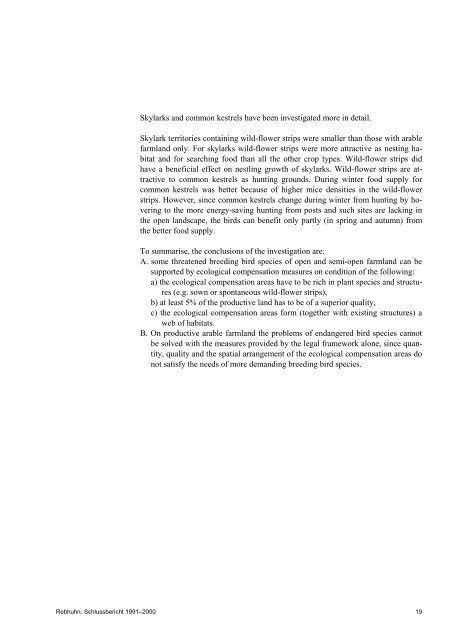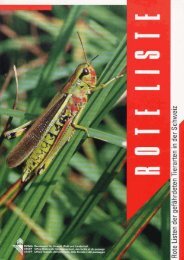Rebhuhn. Schlussbericht 1991–2000 - BAFU
Rebhuhn. Schlussbericht 1991–2000 - BAFU
Rebhuhn. Schlussbericht 1991–2000 - BAFU
Sie wollen auch ein ePaper? Erhöhen Sie die Reichweite Ihrer Titel.
YUMPU macht aus Druck-PDFs automatisch weboptimierte ePaper, die Google liebt.
Skylarks and common kestrels have been investigated more in detail.<br />
Skylark territories containing wild-flower strips were smaller than those with arable<br />
farmland only. For skylarks wild-flower strips were more attractive as nesting habitat<br />
and for searching food than all the other crop types. Wild-flower strips did<br />
have a beneficial effect on nestling growth of skylarks. Wild-flower strips are attractive<br />
to common kestrels as hunting grounds. During winter food supply for<br />
common kestrels was better because of higher mice densities in the wild-flower<br />
strips. However, since common kestrels change during winter from hunting by hovering<br />
to the more energy-saving hunting from posts and such sites are lacking in<br />
the open landscape, the birds can benefit only partly (in spring and autumn) from<br />
the better food supply.<br />
To summarise, the conclusions of the investigation are:<br />
A. some threatened breeding bird species of open and semi-open farmland can be<br />
supported by ecological compensation measures on condition of the following:<br />
a) the ecological compensation areas have to be rich in plant species and structures<br />
(e.g. sown or spontaneous wild-flower strips),<br />
b) at least 5% of the productive land has to be of a superior quality,<br />
c) the ecological compensation areas form (together with existing structures) a<br />
web of habitats.<br />
B. On productive arable farmland the problems of endangered bird species cannot<br />
be solved with the measures provided by the legal framework alone, since quantity,<br />
quality and the spatial arrangement of the ecological compensation areas do<br />
not satisfy the needs of more demanding breeding bird species.<br />
<strong>Rebhuhn</strong>. <strong>Schlussbericht</strong> <strong>1991–2000</strong> 19



